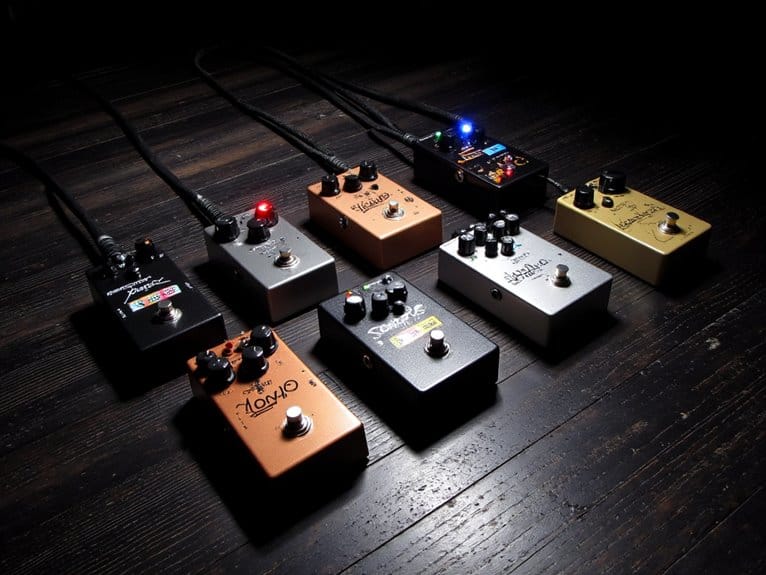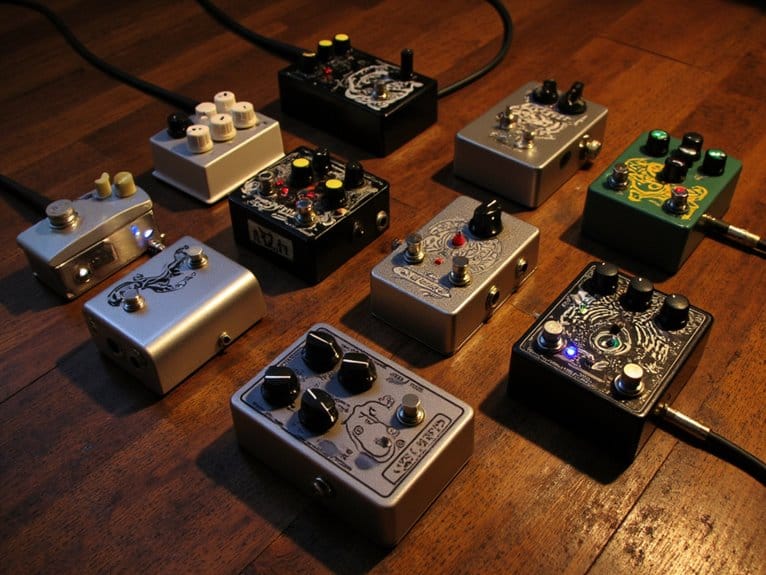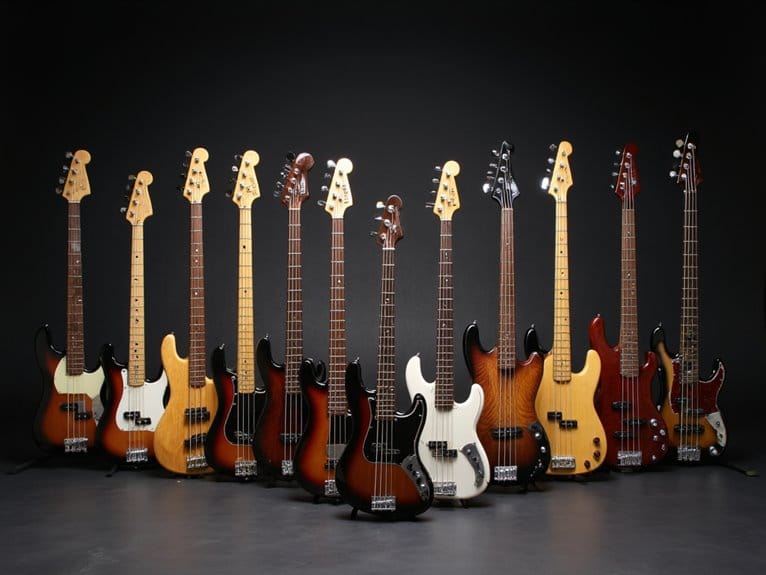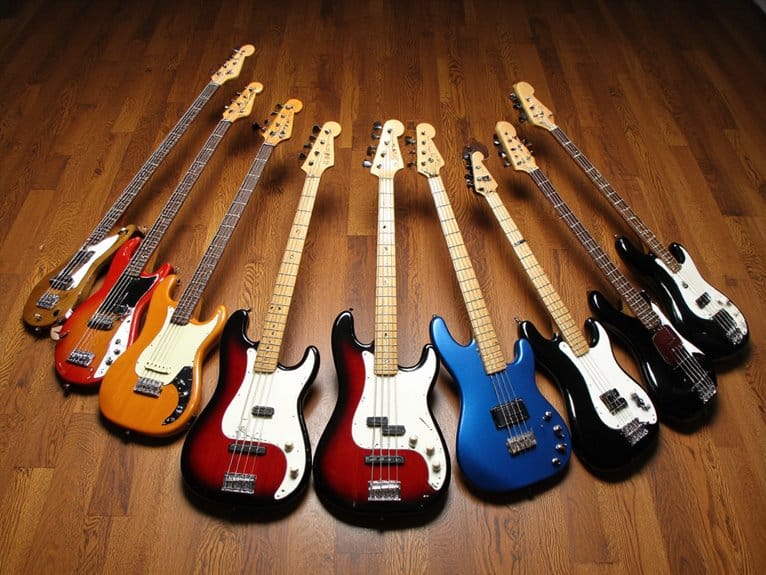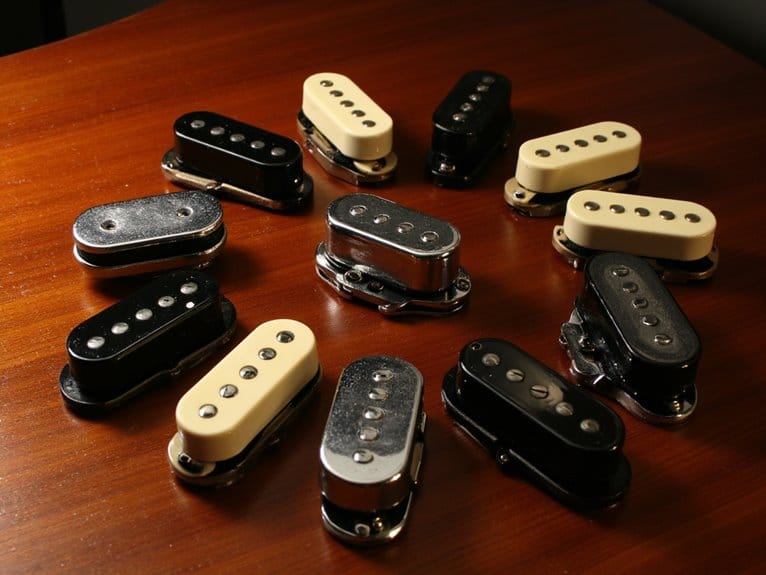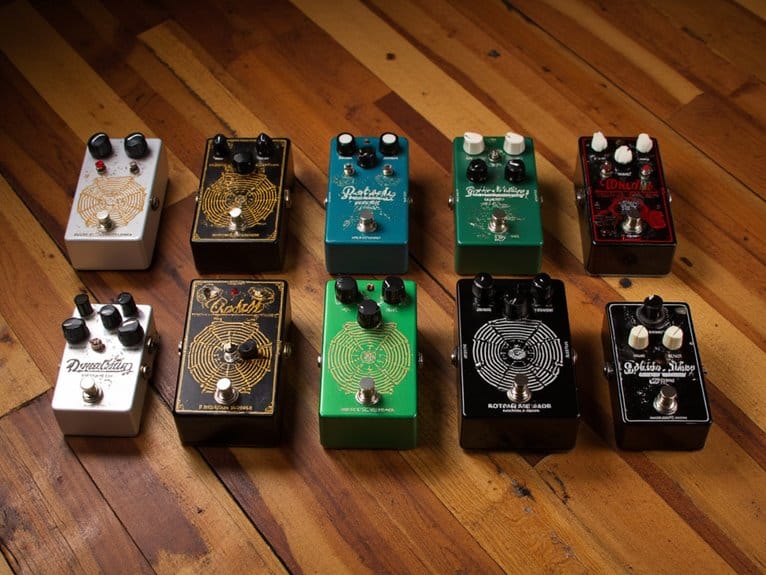10 Best Bass Distortion Pedals That Will Transform Your Sound
I’ve narrowed down the best bass distortion pedals to those that preserve your low-end fundamentals while delivering controlled aggression, including the SanJune US Dream for high-gain American distortion, JOYO’s JF-17 Extreme Metal with extensive 3-band EQ control, and the versatile SONICAKE with dual-mode operation. These analog circuits maintain your instrument’s character through true bypass switching and proper frequency management, unlike cheaper digital alternatives that muddy your tone. The key factors I’ll explore include EQ flexibility, build durability, and power requirements that separate professional-grade pedals from budget disappointments.
We are supported by our audience. When you purchase through links on our site, we may earn an affiliate commission, at no extra cost for you. Learn more.
Notable Insights
- Look for pedals with low-end preservation features and blend knobs to maintain bass fundamentals while adding distortion character.
- Choose pedals with comprehensive EQ controls like 3-band equalizers or sweepable mid frequencies for precise tonal shaping.
- Prioritize true bypass switching and robust metal construction to ensure signal integrity and withstand heavy live performance use.
- Consider dual-mode pedals like SONICAKE or versatile options like JOYO DOUBLE THRUSTER for multiple distortion textures.
- Budget-friendly options like JOYO JF-17 offer professional-grade features, while premium analog pedals provide authentic tube-amp warmth.
[US Dream] Distortion Pedal for Electric Guitar Bass – Mini Size
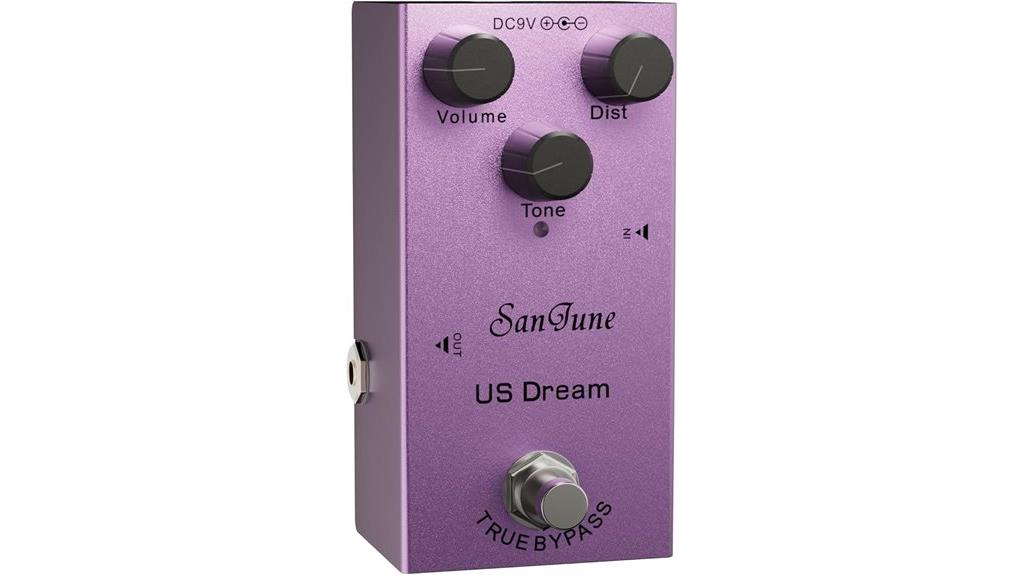
The SanJune US Dream distortion pedal emerges as a compelling choice for bassists who need genuine low-end preservation without sacrificing the aggressive bite that defines classic American high-gain distortion, though I’ll admit its mini form factor initially had me skeptical about its bass-handling capabilities. What surprised me most was how effectively its gain, tone, and volume controls maintain that essential low-end punch while adding the saturated richness you’d expect from high-gain circuitry. The rugged metal housing feels reassuringly solid despite its compact 4.3×3.4×3.6-inch dimensions, and the true bypass switching guarantees your clean tone remains untouched when disengaged.
Best For: Bassists and guitarists seeking a compact, high-gain American distortion pedal that preserves low-end punch while delivering saturated, aggressive tones for live performances and studio recording.
Pros:
- Effectively maintains bass low-end frequencies while providing rich, saturated high-gain distortion suitable for both guitar and bass
- Compact mini design with rugged metal housing offers excellent portability without sacrificing durability for gigging musicians
- True bypass switching preserves original clean tone when disengaged, with responsive gain, tone, and volume controls for versatile sound shaping
Cons:
- No battery operation support limits portability and requires constant access to power supply during performances
- Mini form factor may make precise knob adjustments more challenging during live performance situations
- Limited customer rating sample size (only 4 ratings) makes long-term reliability assessment difficult for potential buyers
JOYO Metal Distortion Pedal with 3 Band EQ (JF-17)
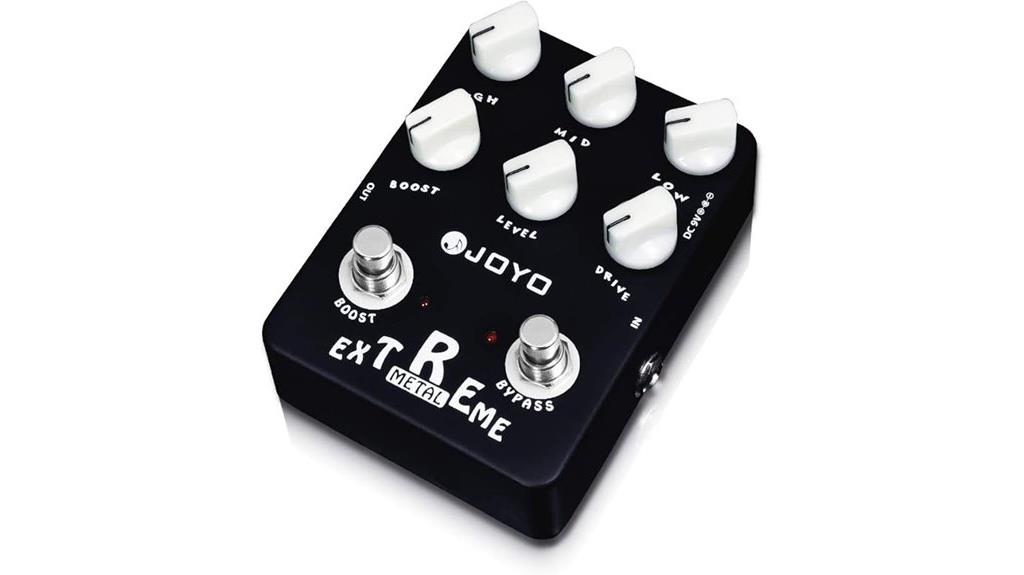
Budget-conscious bassists seeking professional-grade metal distortion without breaking the bank will find exceptional value in JOYO’s JF-17 Extreme Metal pedal, which delivers crushing low-end saturation through its sophisticated 3-band EQ system. You’ll appreciate the adjustable sweep Mid-Freq knob alongside High, Mid, Low, Boost, Level, and Drive controls, giving you precise tonal sculpting capabilities that rival pedals costing twice as much. The rugged aluminum and stainless steel construction weighs 14.5 ounces, ensuring durability for live performances, while the 9-volt power requirement keeps your pedalboard simple and reliable.
Best For: Budget-conscious guitarists seeking versatile metal and hard rock distortion tones with comprehensive EQ control for both practice and live performance situations.
Pros:
- Comprehensive 6-knob control system including adjustable sweep Mid-Freq provides excellent tonal versatility across metal, rock, and punk styles
- Rugged build quality with aluminum and stainless steel construction at an affordable price point, backed by over 6,000 customer reviews averaging 4.3 stars
- Flexible power options (battery or 9V adapter) with standard 1/4-inch connections make it compatible with most guitar setups
Cons:
- Some users report quality control issues and defects that can lead to pedal failure
- Being made in China may raise durability concerns compared to higher-end pedals from established manufacturers
- May require speaker quality consideration as the pedal’s tone characteristics can vary significantly depending on amplifier setup
SONICAKE Distortion Guitar Pedal, Mini High Gain with 2 Modes
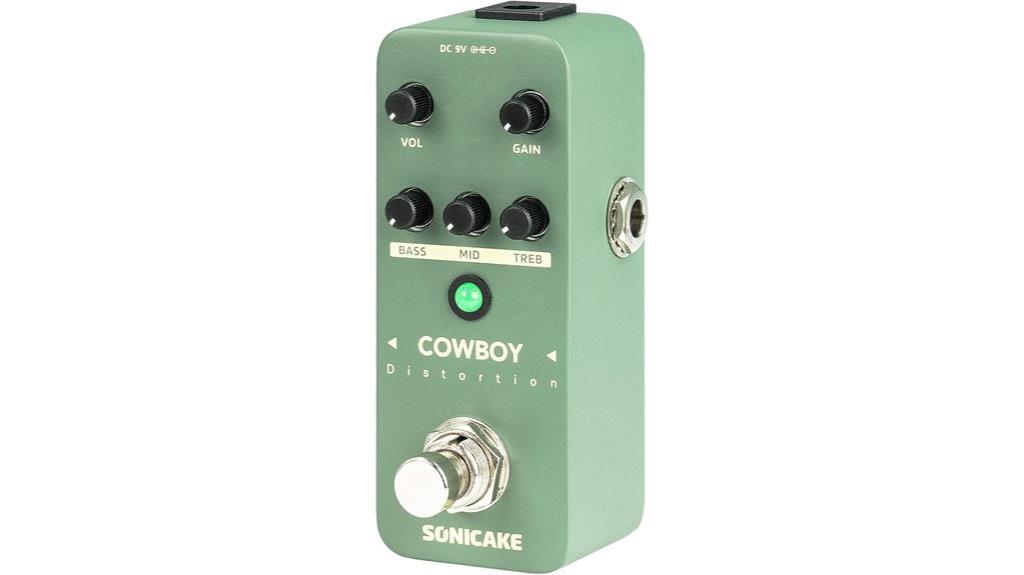
Compact enthusiasts who demand serious gain without sacrificing precious pedalboard real estate will find their match in the SONICAKE Distortion Guitar Pedal, a mini powerhouse that delivers modified groove metal-style distortion through its dual-mode architecture. You’ll appreciate the footswitch-activated mode toggling with LED memory function, which remembers your last setting between sessions. The 9-to-18-volt boost circuit provides enhanced dynamic headroom, while true bypass mode preserves your signal integrity when disengaged. At 7.4 ounces and measuring just 2.52 x 3.98 inches, you’re getting legitimate high-gain capabilities in a surprisingly portable package that’ll handle both electric guitar and bass applications effectively.
Best For: Guitarists and bassists who need high-gain distortion in a compact pedal that won’t take up much pedalboard space but still delivers serious metal-style tones with versatile dual-mode functionality.
Pros:
- Dual distortion modes with LED memory function that remembers your last setting between sessions
- Compact size (2.52 x 3.98 inches) and lightweight (7.4 ounces) design maximizes pedalboard real estate
- 9-to-18-volt boost circuit provides enhanced dynamic headroom and works with both electric guitar and bass
Cons:
- Potential ground loop and hum issues, especially in setups without battery power options
- No battery compartment, requiring external 9V power supply that’s sold separately
- Some users report issues with A+B mode functionality not working as expected
JOYO Bass Guitar High Gain Overdrive Effect Pedal (DOUBLE THRUSTER R-28)
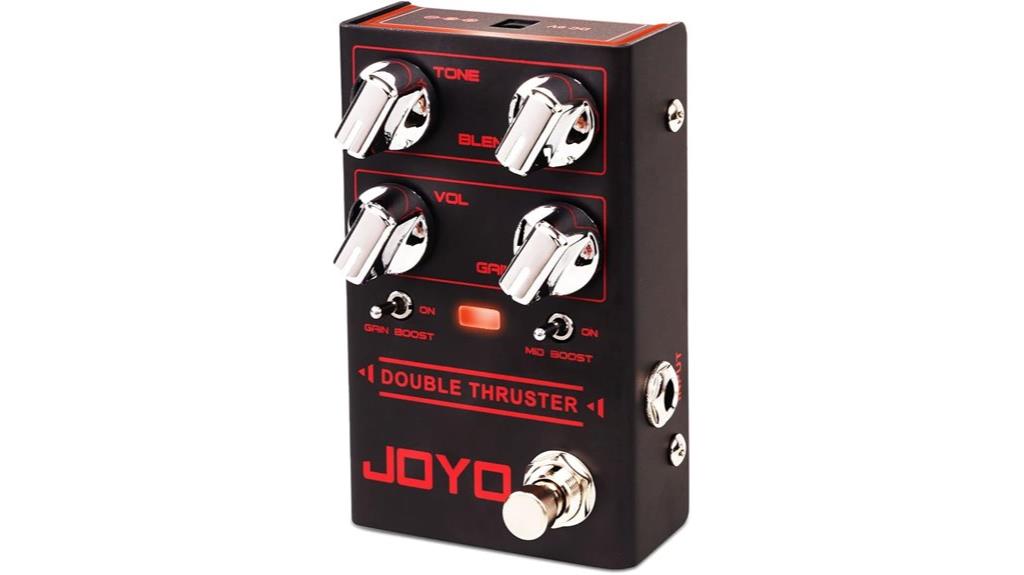
After testing dozens of bass distortion pedals over the years, I’ve found that the JOYO Bass Guitar High Gain Overdrive Effect Pedal (DOUBLE THRUSTER R-28) represents exceptional value for bassists who need versatile overdrive tones without breaking the bank. You’ll appreciate the four control knobs—tone, blend, volume, and gain—alongside the mid-frequency boost and gain boost toggle switches that provide remarkable tonal flexibility. The blend knob particularly impressed me, allowing you to mix clean and overdriven signals seamlessly. While some users report occasional background noise issues, the pedal’s performance rivals higher-priced competitors like Darkglass, making it suitable for everything from jazz to metal applications.
Best For: Bassists seeking versatile overdrive tones across multiple musical styles (pop, rock, blues, jazz, and metal) who want professional-quality sound at an affordable price point.
Pros:
- Exceptional tonal flexibility with four control knobs (tone, blend, volume, gain) plus mid-frequency and gain boost toggle switches
- Outstanding value that rivals higher-priced competitors like Darkglass while maintaining solid metal construction
- Versatile blend knob allows seamless mixing of clean and overdriven signals for various sound textures
Cons:
- Some users report occasional background noise issues during operation
- Requires separate purchase of JOYO 9V DC power supply as it’s not included
- Mixed feedback on enhancement of dynamic playing performance
Boss DS-1 Distortion Pedal
When you’re searching for a bass distortion pedal that delivers reliable rock tones without breaking the bank, the Boss DS-1 stands out as a surprisingly versatile option that’s earned its reputation through decades of consistent performance. With its straightforward three-knob layout featuring tone, level, and gain controls, you’ll find yourself dialing in everything from subtle overdrive to aggressive metal distortion with remarkable ease. The pedal’s analog signal processing maintains your bass’s fundamental character while adding the harmonic richness that cuts through dense mixes, whether you’re channeling grunge-inspired low-end or crafting modern rock tones that demand presence and clarity in today’s competitive sonic landscape.
Best For: Guitarists and bassists seeking an affordable, reliable distortion pedal that can handle everything from subtle overdrive to aggressive metal tones across multiple genres.
Pros:
- Simple three-knob interface (tone, level, gain) makes it easy to dial in desired distortion levels from mild to wild
- Exceptional versatility for various music styles including rock, metal, grunge, and blues with analog signal processing that preserves instrument character
- Outstanding value with proven durability, high customer ratings (4.6/5 stars), and decades of reliable performance
Cons:
- Extremely light weight at 0.02 ounces may indicate less robust construction compared to heavier pedals
- Conflicting power specifications listed (both USB powered and 9V battery) create uncertainty about actual power requirements
- Sound quality can vary significantly depending on the guitar and amplifier used, requiring experimentation to achieve optimal results
Electro-Harmonix Bass Big Muff Pi Fuzz Pedal
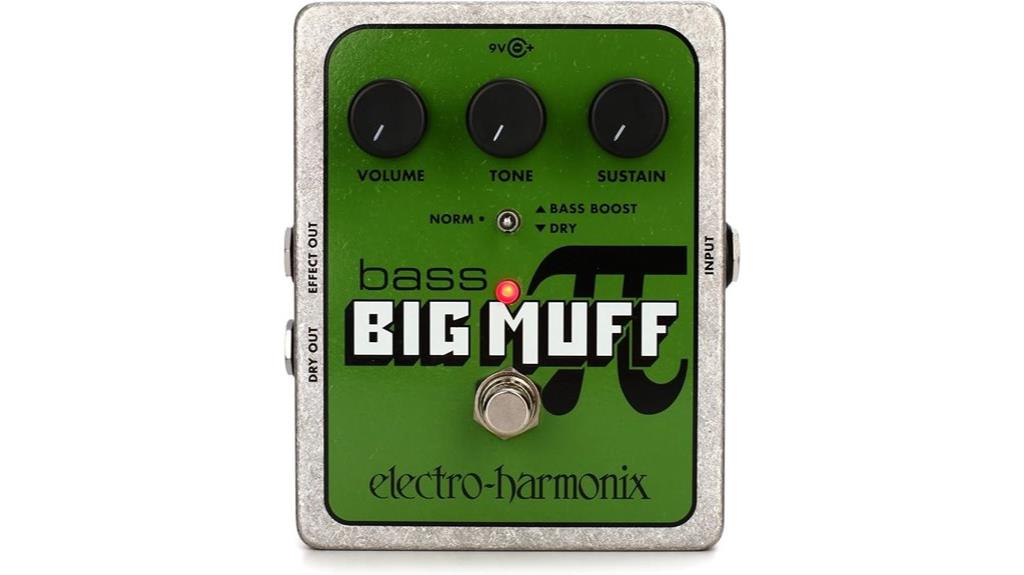
The Electro-Harmonix Bass Big Muff Pi delivers that unmistakable Russian Big Muff fuzz character while addressing the primary concern that keeps bassists awake at night—losing low-end punch in the mix. You’ll appreciate how the dry switch blends your clean signal with the fuzz, maintaining that essential bottom-end foundation that makes or breaks a rhythm section. The bass boost EQ switch cleverly reintroduces low frequencies when you’ve dialed the tone knob toward treble territory, giving you remarkable tonal flexibility without sacrificing the fundamental frequencies your bandmates depend on. With sustain, tone, and volume controls at your disposal, you can craft everything from subtle overdrive to face-melting fuzz.
Best For: Bassists who want classic Russian Big Muff fuzz tones without losing essential low-end frequencies in their mix.
Pros:
- Dry switch allows blending of clean and fuzzed signals to maintain low-end punch
- Bass boost EQ switch compensates for low frequency loss when using treble-heavy tone settings
- Three-knob control layout provides versatile range from subtle overdrive to heavy fuzz distortion
Cons:
- Limited to fuzz/distortion effects only, lacking other bass-specific effects
- Single 9V battery power may require frequent replacements during heavy use
- No mention of true bypass switching which could affect signal clarity when pedal is off
Caline CP-60 Wine Cellar Bass Driver Guitar Effects Pedal True Bypass
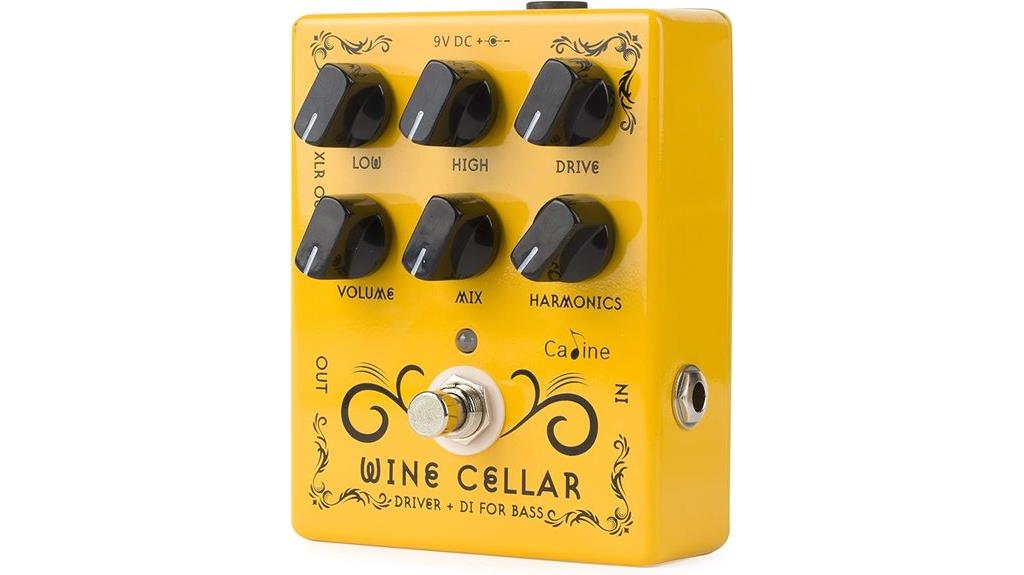
Budget-conscious musicians seeking professional bass tone without the hefty price tag will find the Caline CP-60 Wine Cellar Bass Driver a compelling solution that punches well above its weight class. This aluminum alloy-constructed pedal delivers clean, thick sound through its Drive, High/Low frequency, HF Harmonics, and Mix controls, while true bypass design preserves your original tone integrity. The analog cabinet emulation circuitry provides excellent direct input capabilities for recording and small venues, effectively replacing bulky amplifiers. Though some users report requiring higher volume settings, the CP-60’s robust construction and sound fidelity consistently earn favorable comparisons to pricier alternatives like Sansamp models.
Best For: Budget-conscious bassists who need a reliable direct input solution for recording, small venues, and practice sessions without sacrificing professional sound quality.
Pros:
- True bypass design with analog cabinet emulation provides clean, thick bass tone while preserving original signal integrity
- Durable aluminum alloy construction with robust controls offers excellent value compared to higher-priced alternatives like Sansamp models
- Versatile functionality as both preamp and DI box eliminates need for bulky amplifiers in various settings
Cons:
- Requires higher volume settings to achieve optimal output levels according to some users
- Mixed user feedback on overall volume performance may require adjustment of other equipment settings
- Entry-level positioning may not satisfy professional bassists seeking premium features found in more expensive units
Boss ODB-3 Bass Overdrive Pedal
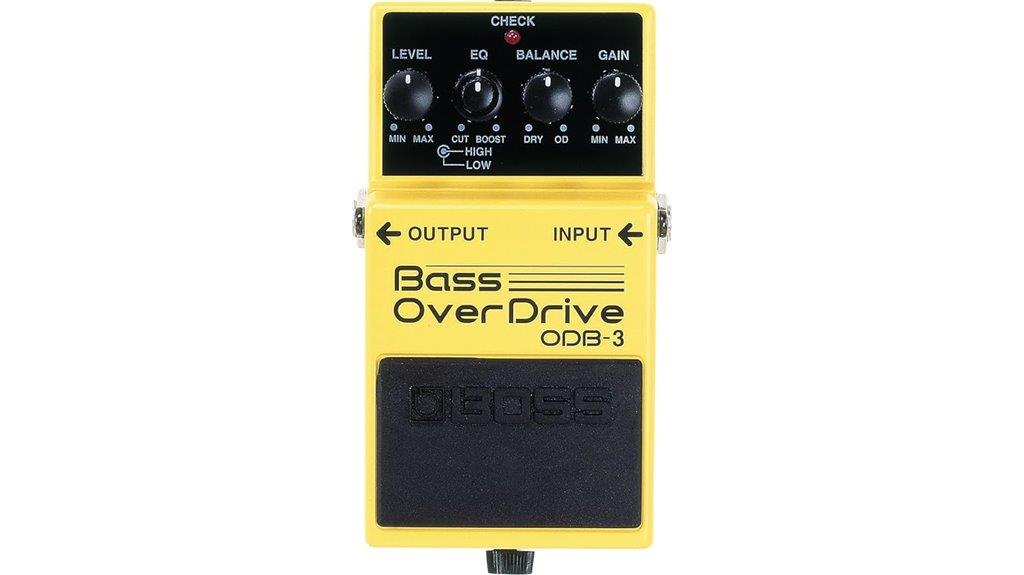
Bassists who crave versatility in their overdrive arsenal will find the Boss ODB-3 Bass Overdrive Pedal particularly compelling, thanks to its built-in balance control that lets you blend clean and overdriven signals seamlessly. This compact yellow pedal delivers everything from mild warmth to aggressive distortion while maintaining essential low-end clarity, though some users report occasional noise issues when engaged. The onboard two-band EQ provides additional tonal shaping options, making it effective for hard rock, thrash, and punk applications across four- and five-string basses, with competitive pricing and solid build quality.
Best For: Bassists seeking versatile overdrive effects who want to blend clean and distorted signals while maintaining low-end clarity for hard rock, thrash, and punk genres.
Pros:
- Built-in balance control allows seamless blending of clean and overdriven signals
- Maintains low-end clarity without muddiness, essential for bass applications
- Onboard two-band EQ provides additional tonal shaping from mild overdrive to heavy distortion
Cons:
- Some users experience unwanted noise or hiss when the pedal is activated
- Mixed customer feedback on overall sound quality not meeting expectations
- Limited to analog signal format which may not suit all modern setups
Electro-Harmonix Deluxe Bass Big Muff Pi Bass Effects Pedal
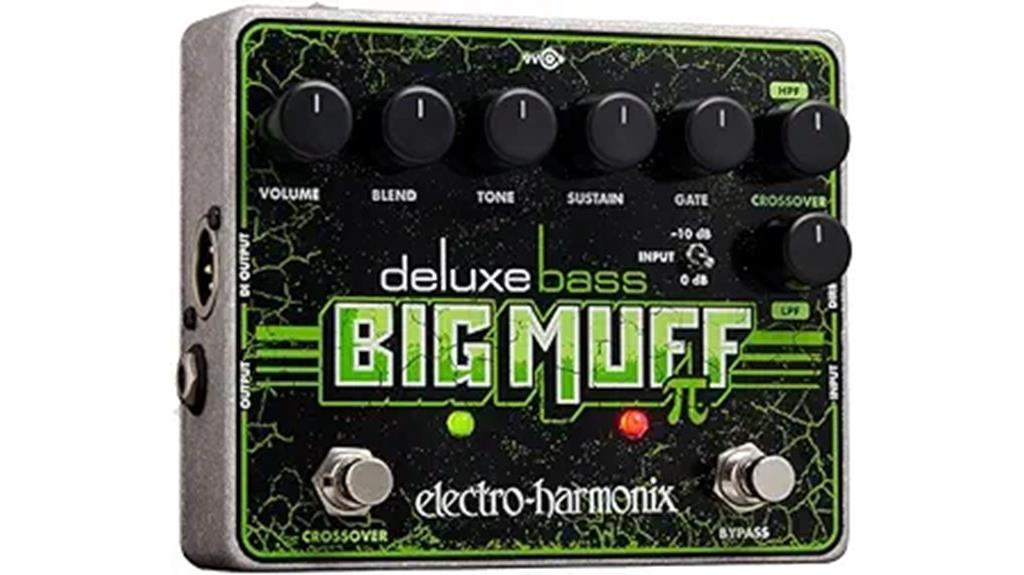
Enhanced with a sophisticated blend control and foot-switchable crossover section, the Electro-Harmonix Deluxe Bass Big Muff Pi stands out as the premier choice for bassists who demand precise tonal sculpting without sacrificing their instrument’s fundamental low-end clarity. You’ll appreciate how the variable low pass filter maintains your dry signal’s warmth while the high pass filter shapes your distorted tone, creating everything from subtle sizzle to aggressive fuzz textures. The three outputs—quarter-inch effect, buffered direct, and XLR DI—provide remarkable studio and live flexibility, though I’ve noticed the fuzz can sound thinner than some players prefer.
Best For: Bassists seeking versatile fuzz capabilities with precise tonal control and the ability to maintain low-end clarity while having multiple output options for studio and live performance flexibility.
Pros:
- Sophisticated blend control and foot-switchable crossover section allow for intricate sound sculpting from subtle sizzle to aggressive fuzz
- Three output options (1/4″ effect, buffered direct, and XLR DI) provide excellent flexibility for studio recording and live performances
- Built-in noise gate eliminates unwanted hum while switchable input options accommodate both passive and active pickups
Cons:
- Fuzz sound can be thinner than some players desire for heavier distortion applications
- Certain settings may mute pick dynamics, reducing playing expression
- May not satisfy bassists specifically seeking heavy distortion tones rather than traditional fuzz characteristics
Factors to Consider When Choosing a Bass Distortion Pedal
When I’m helping bassists choose their ideal distortion pedal, I’ve learned that several critical factors can make or break your satisfaction with the purchase, ranging from the fundamental sound character that defines your tone to the technical specifications that guarantee reliable performance. The tonal qualities you’re seeking—whether that’s aggressive fuzz, smooth overdrive, or cutting distortion—must align with your musical style, while practical considerations like EQ flexibility, construction quality, and power requirements directly impact your pedal’s usability in real-world situations. I’ll walk you through each essential factor, sharing insights from years of testing different pedals, so you can make an informed decision that serves your bass playing for years to come.
Sound Character and Tone
Anyone who’s spent time exploring bass distortion pedals quickly discovers that sound character represents the most subjective yet vital aspect of pedal selection, as what sounds perfectly gritty and defined to one player might come across as muddy or overly harsh to another. I’ve found that understanding different distortion types becomes essential, since smooth overdrive adds warmth while aggressive fuzz delivers pronounced crunch, fundamentally altering your musical style. The best pedals maintain low-end clarity while enhancing mid and high frequencies for balanced tonal profiles, though this balance varies dramatically between classic American high-gain settings and modern metal-inspired modes. Features like adjustable EQ settings and blend controls let you mix dry signals with distorted sounds, providing greater control over tonal outcomes and overall richness.
EQ and Frequency Control
Building on these tonal foundations, the EQ and frequency control capabilities of your bass distortion pedal will determine whether you achieve that perfect balance or end up with a muddy, indistinct mess that sits poorly in your mix. I’ve learned that multi-band EQ setups are essential, giving you independent control over high, mid, and low frequencies to sculpt your sound precisely. The balance control feature, which I can’t emphasize enough, lets you blend dry and overdriven signals seamlessly, maintaining that vital low-end clarity while adding grit. Look for pedals with sweepable mid-frequencies—these allow you to target specific problem areas and adapt your tone for different musical styles, ensuring your bass cuts through without losing its fundamental punch.
Build Quality and Durability
The longevity of your bass distortion pedal depends heavily on its construction materials and engineering design, because I’ve seen too many promising pedals fail after just a few months of regular gigging. I always look for units built with metal or aluminum alloy housings, which handle the inevitable drops and transport abuse that come with live performance. Compact designs often surprise me with their durability, featuring reinforced construction that actually outlasts bulkier alternatives. True bypass switching protects your original tone while extending internal component life, and I’ve learned that pedals under one pound typically offer the best portability-to-strength ratio. The quality of knobs and switches tells the real story though—robust components survive countless soundchecks and late-night rehearsals without developing the wobble or crackling that kills otherwise excellent pedals.
Power Supply Requirements
Most bass distortion pedals stick to the standard 9V DC power requirement, but I’ve learned that understanding your specific pedal’s power consumption in milliamps becomes critical when you’re building a larger pedalboard setup. I typically see distortion pedals drawing between 10-30mA, which sounds minimal until you’re powering six or seven effects simultaneously. What catches me off guard sometimes is the connector compatibility issue, since some pedals require center-negative plugs while others demand proprietary adapters that manufacturers don’t always include in the box. I’ve found that certain models offer dual voltage options, allowing 9V or 18V operation for enhanced dynamic range, though this feature isn’t standard across all designs. Battery operation remains hit-or-miss with compact pedals.
True Bypass Vs Buffered
Once you’ve sorted out your power supply situation, you’ll need to tackle one of the most debated topics in the bass effects world: true bypass versus buffered bypass switching. I’ll admit, this subject can spark heated discussions among players, but the choice really depends on your specific setup requirements.
True bypass circuits maintain your bass’s natural tone by allowing the signal to pass directly through when the pedal’s off, which purists absolutely love for preserving those pristine dynamics. However, buffered bypass pedals use active circuitry to maintain signal strength over long cable runs, preventing high-frequency loss that can plague complex rigs. If you’re running multiple effects or long cables, buffered systems often provide more consistent performance, though they might subtly color your tone.
Blend and Mix Controls
After years of playing through countless distortion pedals, I’ve learned that blend and mix controls represent perhaps the most vital feature for bassists who refuse to sacrifice their instrument’s fundamental low-end presence. These controls allow me to combine my dry, unaffected signal with the distorted output, maintaining clarity in those vital low frequencies while adding the character and grit I’m seeking. I can dial in anything from subtle overdrive warmth to aggressive fuzz tones without losing my bass’s original voice. The real-time adjustability proves invaluable during live performances, letting me adapt to different songs and venues instantly. This feature prevents that muddy mess that traditional distortion often creates, ensuring my low end stays tight and defined.
Size and Portability
When I’m selecting a bass distortion pedal, size and portability considerations often determine whether a particular unit becomes a permanent fixture on my pedalboard or gets relegated to home studio duty. I’ve found that compact models measuring 2 to 4 inches in height and width, weighing between 7 to 14 ounces, strike the perfect balance for gigging musicians who can’t afford unnecessary bulk. Mini distortion pedals have become my go-to choice for travel situations, offering space-saving benefits without compromising essential features. I appreciate when manufacturers include durable metal housing, which withstands transport abuse better than plastic alternatives. The 9V power supply requirement simplifies setup logistics, though I sometimes miss battery operation flexibility. True bypass functionality guarantees my signal integrity remains intact when the effect’s disengaged, making these portable units genuinely practical.
On a final note
I’ve tested countless bass distortion pedals over the years, and these eight options represent the best value, performance, and versatility available today. Whether you’re seeking vintage warmth from the Bass Big Muff Pi or modern precision with the Boss ODB-3, there’s something here for every playing style and budget. Remember to take into account your amp’s characteristics, band dynamics, and personal tone preferences when making your final decision.

